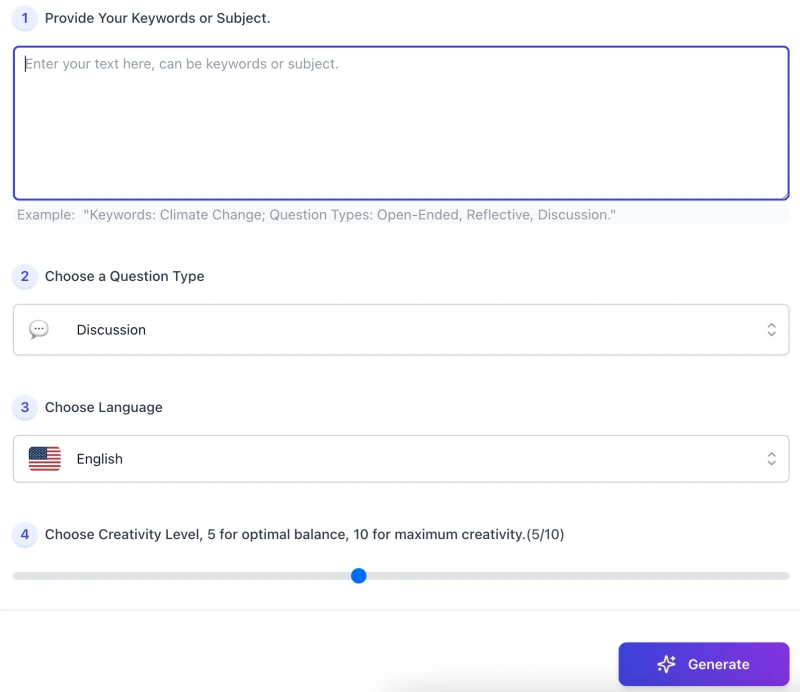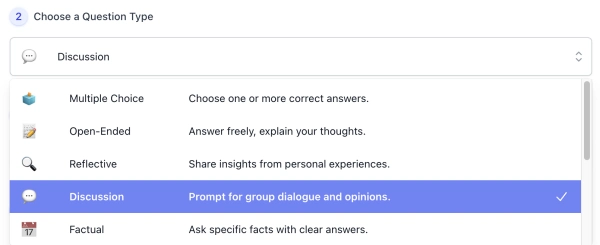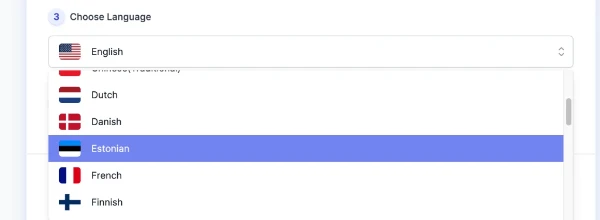Free AI Tools. No Sign-Up Required. Full Access.
AI Question Generator
Free AI tool to generate questions online — no sign-up, perfect for teachers, students, and trainers.
Combine the current tool with these other tools to work more efficiently.
Discover other tools with functions and purposes similar to the one you are currently viewing.
Discover the tools most favored and highly-rated by users on our website.
Explore more AI tools in these related categories
AI tools that automatically create text content for your images, audio, or video from user prompts.
Empower education with AI-driven tools for teaching and learning excellence.
AI tools designed to assist with research, studying, writing, and academic data analysis tasks.
This is the AIFreeBox AI Question Generator online tool page — a collaborative assistant for designing question drafts. It is not a generic question generator. Built for teachers, trainers, students, and content creators, it provides direction and structure so you can quickly shape quizzes, discussion prompts, reflection tasks, data-reading items, and debate questions, then refine them for accuracy and relevance.
On this page you’ll find what the tool can do, where it works best, how to use it, practical tips, known limitations with fixes, and FAQs — all focused on helping you create questions that fit your specific context and purpose. Available on free and ultra plans.
What Can AIFreeBox AI Question Generator Do?
AIFreeBox AI Question Generator is built on transformer-based large language models, fine-tuned for educational and professional question design. It applies natural language understanding with structured output control, so the generated questions align with the chosen topic, style, and audience needs.
The tool follows a human–AI collaboration model: you set the direction and provide the key points, and it helps organize, expand, and present them in question form. This process gives you a clear starting framework, making it easier to review, adjust, and finalize content that works for your specific context.
It supports 33 languages and 20 combined style types, giving you a practical range of formats for quizzes, discussion prompts, reflection tasks, and assessment activities — helping you focus more on reviewing and refining, rather than starting from scratch.
AIFreeBox AI Question Generator vs. Generic Question Generator
| Dimension | AI Question Generator (This Tool) | Generic Question Generator |
|---|---|---|
| Content Quality | Produces clear, well-structured drafts aligned to the topic and chosen type; easy to review and refine. | Often generic and unstructured; weak alignment to specific needs. |
| Value | Gives direction and a workable framework to build a quality question set. | One-off output with uneven quality; limited guidance. |
| Engagement (Human–AI) | User leads selection and editing; AI helps organize and extend ideas. | Minimal user involvement beyond entering a topic. |
| Result Usability | Drafts are easy to adjust, adapt, and integrate into real teaching or creation workflows. | Often requires heavy rework before use. |
This comparison shows how the tool focuses on structured, collaborative output that supports refinement, rather than one-off, generic questions.
Recommended Uses and Benefits
| Use Case | Problem Solved | Who Benefits |
|---|---|---|
| Classroom and Online Teaching | Saves time preparing diverse, structured questions for quizzes, exams, and interactive lessons. | Teachers, tutors, and education content creators. |
| Training and Workshops | Helps design scenario-based and analytical questions to assess skill application. | Corporate trainers, HR teams, professional coaches. |
| Content Creation & Media | Generates engaging prompts to spark discussion, polls, and audience interaction. | Podcasters, YouTubers, social media managers. |
| Study Guides & Self-Testing | Creates targeted practice questions to reinforce knowledge and check understanding. | Students, exam candidates, self-learners. |
| Idea Brainstorming | Provides starting points for discussion or creative thinking in collaborative sessions. | Writers, researchers, innovation teams. |
This tool works best when used as a guide for building question sets tailored to your specific teaching, training, or content goals.
How to Create Questions with AIFreeBox AI (Step-by-Step)

Step 1 — Provide your keywords or subject
Enter a short, specific topic. You may add audience or constraints (e.g., “Grade 9 biology, photosynthesis, short answers”). Focused topics lead to clearer drafts.
Step 2 — Choose a question type

Select a preset such as Quick Quiz, Discussion, Reflection, or Data Read. The preset guides structure and depth.
Step 3 — Choose language

Pick the language for both input and output. The tool writes in the language you select.
Step 4 — Set creativity level
Use the slider to balance control and variety. 5/10 is a practical default; lower values keep tighter alignment, higher values explore more options.
Step 5 — Generate
Click Generate. The tool produces a concise set of draft questions aligned to your topic and chosen type.
Review & Edit
Read the draft carefully. Adjust wording, accuracy, difficulty, and context fit. Add examples or constraints as needed. The AI provides direction and structure—you decide the final form.
Step 6 — Download or Copy
Use Download to save a file, or Copy to paste directly into slides, documents, or LMS notes.
Step 7 — Report Bug and Feedback ( Real Human Support )

If something looks wrong or unclear, click Report Bug. Your message goes directly to our support team—real people who review every report and respond promptly. Please include your topic, selected question type, language, creativity level, and a brief description or screenshot so we can resolve it quickly. We take user experience seriously and fix issues with care.
Summary: Treat the generated content as a starting point and source of ideas. Review and refine to ensure it meets your goals and audience before use.
Writing Tips for Creating High-Quality Questions
- Be clear about your goal — Know whether you want recall, analysis, reflection, or discussion before you start.
- Choose one preset — Pick the question type that best matches your intent; avoid mixing styles in the same run.
- Use specific keywords — Provide focused, relevant terms so the AI stays on topic.
- Match tone to audience — Keep language and complexity suitable for your learners or readers.
- Balance depth and simplicity — Ask questions that are challenging but still understandable.
- Check and refine — Review generated questions, adjust wording, and ensure they fit your exact purpose.
These tips help you move from basic outputs to well-targeted, usable questions that truly match your needs.
User Case Study: Real-World Use of AIFreeBox AI Question Generator
Case 1 – Teacher Creating a Class Quiz
Goal: Prepare a short quiz for a history lesson on World War II.
Process:
- User Input:
- Content: “World War II, key events, causes, major battles”
- Question Type: “Multiple Choice”
- Language: English
- AI Output:
- Generates 8 well-structured multiple-choice questions, each with four answer options.
- Example:
Q: Which event marked the official start of World War II?
A) Attack on Pearl Harbor
B) Invasion of Poland ✅
C) Battle of Britain
D) Fall of France
- Human Refinement:
- Teacher reviews each question, adjusts wording for age-appropriateness, and swaps one question for a more relevant local historical reference.
- Example Edit: Changed “Invasion of Poland” question to include the date for clarity:
Q: Which event on September 1, 1939, marked the start of World War II?
Result:
A complete quiz outline ready for the classroom in under 10 minutes, aligned with the lesson plan and student level.
Question Types Overview
- 🔘 Quick Quiz — Recall · Single choice (Classroom, Tests)
- ✍️ Concept Check — Explain · Short answer (Lessons, Training)
- 🛠️ Solve Problem — Solution under limits (Math, Logic)
- 🔬 Analysis — Analyze · Long answer (Essays, Research)
- ⚖️ Compare — Compare · Short answer (Debate, Reports)
- 🔮 Predict — Hypothesize · Reasoning (Science, Trends)
- 🧭 Evaluate — Judge · With criteria (Review, Feedback)
- 🧾 Evidence-Based — Claim · Evidence (Essays, Persuasion)
- 🪞 Reflection — Personal insight (Journals, Coaching)
- 💬 Discussion — Group dialogue (Workshops, Forums)
- 📊 Data Read — Interpret charts/tables (Reports, Exams)
- 🌀 Cause & Effect — Explain · Cause/outcome (History, Science)
- 🎟️ Exit Ticket — Quick end check (Classroom wrap-up)
- ⚔️ Debate — Argue with evidence (Class, Clubs)
- 🗒️ Interview — Survey questions (Research, HR)
- ✅ Multi Select — Select all correct (Quizzes, Polls)
- 🔢 Rank Order — Arrange by rule (Priority setting)
- 🧩 Match Terms — Pair term/definition (Language, Training)
- 🧱 Fill Blank — Complete missing words (Language, Exams)
- 🧪 Case Apply — Apply · Short answer (Law, Medicine)
Limitations & Solutions
| Limitation | Possible Issue | Solution |
|---|---|---|
| Not a fact-checker | Generated questions may contain outdated or incorrect information | Verify all facts and data before use |
| Depends on your input | Vague prompts lead to generic or unfocused questions | Provide clear topic, audience, and purpose |
| Single style per run | Cannot combine multiple question styles in one generation | Run separate sessions for each style needed |
| May miss context | Does not always capture niche or local cultural context | Add specific examples or context manually |
| Language nuance | Direct translations may lose tone or precision | Review and adjust wording for the target language |
FAQs
Can I use AI Question Generator for all types of questions?
No. This tool is not a universal question generator. It works best when you provide a clear topic, audience, and purpose. For highly specialized or niche topics, you may need to refine or add details manually.
Will the generated questions be 100% accurate and ready to use?
No. The AI provides draft questions as a starting point. You must review, fact-check, and adjust them to match your context and ensure accuracy before use.
Can I generate multiple question styles at once?
No. The system supports single style selection per generation to maintain clarity and focus. If you need different styles, run separate sessions for each.
Does the tool work in multiple languages?
Yes. It supports 33 languages. However, language nuance and cultural context may require manual adjustments for tone and clarity.
How does “Report Bug” help me?
When you submit a bug report, our support team reviews it directly. This ensures quick fixes, continuous improvement, and a better overall experience for you.
Can I rely on the AI to handle cultural or context-specific questions?
Not entirely. While the AI can suggest structured questions, it may miss subtle cultural references or local context. Always add or adapt content to fit your audience.
What’s the best way to get high-quality results?
Be specific in your input. Include topic, target audience, difficulty level, and desired style. The clearer your guidance, the more relevant and usable the draft questions will be.
Creator’s Note
AI Question Generator was designed with a clear belief: AI should not replace the thinking process, but support it.
This tool helps you organize ideas, structure questions, and save time — but the insight, accuracy, and final touch come from you. Every question it drafts is a starting point for your refinement, not a finished product.
By combining AI’s speed with your judgment, we can create questions that are not only relevant, but also meaningful to the people who answer them.
2025-10-23
❓ Try it out now — free, online, and ready when you are.
Spark deeper thinking — let AI help you craft smart, relevant, and engaging questions for any topic or audience.